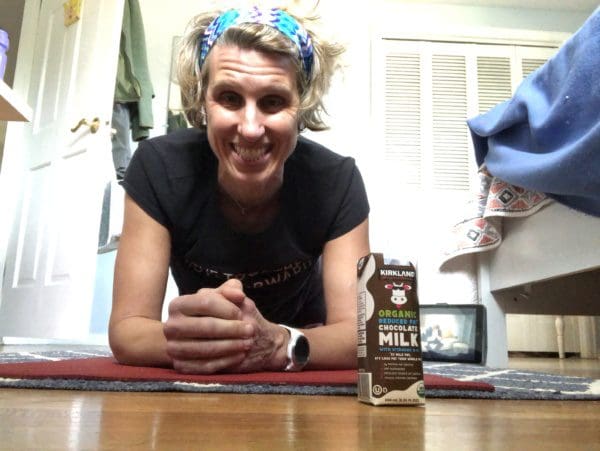
Hitting the quads with a post-workout chocolate milk and Netflix in the background.
On a random Saturday in March, I—Dimity—went to pee after a long indoor bike ride that included lots of simulated climbing: high resistance, low cadence. I squatted to about 30 degrees, then my knees screamed as loud as a overtired, oversugared toddler who stayed too long at a birthday party.
I grabbed the sink in front of me for support and slowly lowered my aching body. My knees—the front kneecaps in particular—have always been cranky, but to have them feel so angry after a non-impact bike ride was scary. I already gave up running; now I was going to have to give up cycling too?
Not so fast, drama queen.
Despite feeling knee pain from cycling over the past few months, I had done exactly, um, nothing to heal, prevent, minimize, or stop it. And guess what? That’s not an effective strategy, especially for a nearly-50-year-old body with a history of injury.
Something needed to change. But instead of shedding tears—my typical MO—about the hobbling bathroom situation, I called my pal Adrienne Martini.
I knew foam rolling had the potential to be a serious salve for my knees; releasing and relaxing the muscles around the knees, particularly my quads and calves, loosens tightness and encourages circulation. So I roped Adrienne into a casual 30-day challenge: Could we both foam roll for 10 minutes a day for the month of April?
Thankfully, she was game—and we tossed around the idea of future 30-day challenges. (Pet your dog every hour on the hour for 30 days straight? We could nail it!).
For now, we concentrated on foam rolling, which is a self-myofascial massage that encourages healing blood flow, increases range of motion, and reduces inflammation and soreness. (A deeper dive into details here.)
And little did we know, in early April, that tomorrow is National Foam Rolling Day, so we’re giving ourselves bonus points for being trendy and on time.
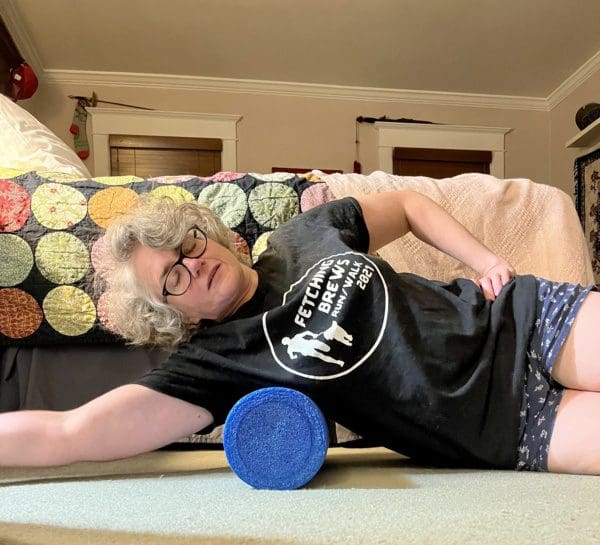
Adrienne “relaxes” at the end of the day.
Adrienne’s history with foam rolling: I was first introduced to foam rolling at an AMR retreat a few years ago. Kolleen’s Trigger Point workshop was the bomb. Yes, getting in there and rolling parts of my body that had never met a roller—like my pecs (ow.)— felt like its own painful workout, but I spent the next 24 hours feeling delightfully light on my feet. “I’m going to keep this up!” I thought. And then I promptly did not keep it up. If I had a new ache, I’d roll around it with abandon for a few days, then abandon the foam roller.
Dimity’s history with foam rolling: Given my history as a sports + fitness writer, I have known about foam rolling and its benefits since before AMR existed. That said, if I have foam rolled more than a dozen times in a year for most of the past decade, I’d be surprised. It’s one of those things that I mentally know is helpful, that I’ve physically felt is helpful, that requires not.that.much effort, and yet still manages to slip through the cracks.
A typical 10-minute session for Adrienne went like this: I always go from the bottom up so I start with rolling the bottoms of my feet on a ball, then lay down for calves and quads. Sometimes, I rest my bum on the roller and hit my glutes (which I’m not sure is Kolleen- approved but feels great). Then I roll on my side near my bra band and those troublesome pecs. I finish everything off with a few cat-cow poses, just because.
A typical 10-minute session for Dimity went like this: First, I always start my watch. I need that validation of seeing the session show up on my weekly workout totals. Then I hit the body part what felt like needed it most. My quads and inner thighs got the bulk of the attention (usually about 5 minutes for both legs). Glutes and calves also got ample love (3 minutes for either part), and sometimes I targeted my shins, which is basically akin to walking on sharp gravel in bare feet. I rarely hit my upper body, although I did roll my mid-to upper back a few times.
I always stop when my watch read 10 minutes; I am not angling for any bonus minutes.
Moves to foam roll your calves, quads, Vastus Lateralis (IT Band) and thoracic spine. Demonstrated by Kolleen Riddick-Losch, a TriggerPoint Master Trainer and founder of Core 57 in Alpharetta, Georgia.
The part of Adrienne’s body that loved the roller the best: Love might be pushing it but the upper parts of my calves always felt looser after a roll. How can that one spot get so tender?
The part of Dimity’s body that loved the roller the best: Definitely the quads. Especially the outer edge, right above the knee, that you feel when you flex your quad. Plant that on the roller, do a little shimmy left and right, then bend the knee to lift the heel towards the butt. Hurts so perfectly.
Other benefits Adrienne felt: The biggest benefit was how much more aware I am of how my muscles slide over each other, which is a weird thing to be aware of. I definitely noticed when one of the muscles in my hamstrings that is closer to the surface felt like it was stuck to another muscle in the complex closer to the bone.
Other benefits Dimity felt: Mentally, I liked knowing I was actually doing something for my (aging) body to make it feel better. While I certainly warm-up on the bike, I typically jump on, and spin at an easy resistance for 10 or so minutes while I play Wordle. This felt way more intentional and, as such, was likely more effective.
Moves to foam roll your hip flexors, pecs and lats (you’ll be surprised what happens to your running when you release muscles in your upper half!). Demonstrated by Kolleen Riddick Losch, a TriggerPoint Master Trainer and founder of Core 57.
How many days Adrienne missed: Three. Call it an A-.
How many days Dimity missed: Six-ish? I definitely just blanked on it on rest days. And there were some days when I kept pushing it back in the day—and on my priority list—that the poor foam roller didn’t have a chance to do her job. I’d probably get a B- if this were a true assignment.
Misc. thoughts from Adrienne: When the 30 days ended, I figured I wouldn’t continue routine rolling, just because I didn’t feel like I got a huge bang for my buck. But here we are, ten days past the end of April and I’m still rolling. It’s a good way to close out the day for me—and I really enjoy squishing some knots out of my hip flexors.
Misc. thoughts from Dimity: I felt best when I foam rolled prior to a ride; not only were my muscles warmed up and my mind focused on moving, but I also liked knowing when I was done with the workout, I’d be done with everything workout-related. If I didn’t get it done preride, I’d try to be diligent about getting it done before I got out of my exercise clothes and transition to a “real” person.
On days I left the rolling for later in the day, I really appreciated advancements in the stretch of denim. Yes, you can easily roll in jeans. (And yet one more excuse flies by the wayside…)



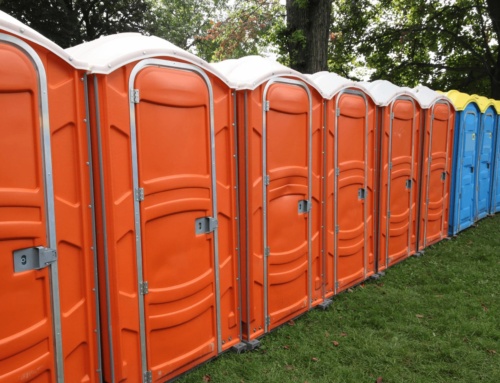
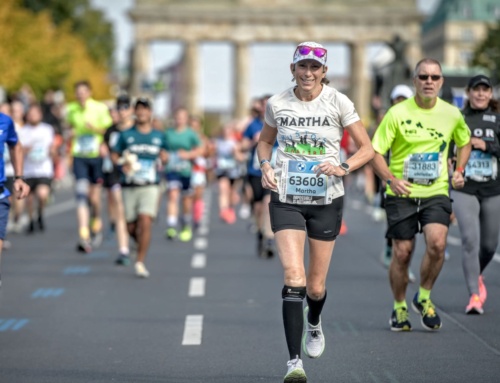
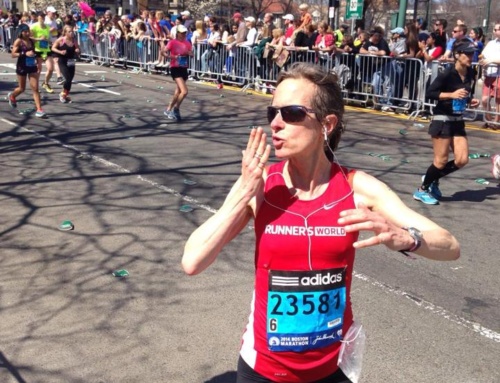
Good work! I’m a total believer. I rolled faithfully every training day for half-ironman and running-race training. A former TLAM coach told us to roll sometime before bed on every day we ran, and I complied! I gave it total credit for keeping me injury free. For the last year and a half, though, I’ve been walking about 20 miles a week with my husband, and I totally let the rolling slide, thinking it was “just walking”…but was rewarded with a nasty case of plantar fascitis. I started rolling faithfully again, usually before AND after the walk, and I’m on the mend…and devoted to never falling off the foam rolling wagon again! And Dimity….how are your knees doing now?!
I got super diligent about foam rolling when running high mileage because my coach told me to do it. I don’t usually need outside authority to boss me around – actually, I generally hate that – but in the case of foam rolling, it turned out to be super effective. I also do not do group exercise challenges, but if AMR put out a foam rolling challenge, I’d be all over that one! [Hint, hint?]
I was so excited by Kolleen’s foam rolling class at the HH BAMR Retreat that I went home and signed up to get certified in Trigger Point Foam Rolling. Decent CEU credits and forced foam rolling. I start the class this week!
I’m rolling about 3-4x week? I like to roll my calves before a run to help warm up my Achilles. No shade to the AMR classes (which are excellent) but I usually do the Peloton foam rolling classes with Hannah Corbin. There’s about 14 different classes.
Dimity and Adrienne, I’d totally fit in in your “seldom-to-never” foam rolling club! I know it’s good for me, I know I feel lighter after I do it, I know I SHOULD do it, but somehow, I just don’t. Not with any kind of regularity, anyway. I loved reading about your 30-day stint, and you *might* even have inspired me to give it a try myself. Maybe … ;)
In the past, I’d pretty much only spend quality time on my foam roller when I saw the FR on my training plan. Maybe roll my glutes between massages if they felt tight. My most recent stint in PT has made it part of (almost) daily life in the past month. I like to start at the bottom – shins, calves – and work my way up – quads, TFL, hamstrings, glutes… The more often I do it, the less it hurts. I can’t say the same for cupping. I’d like to keep it up but my track record isn’t stellar…
Goodness, I must admit that a challenge would certainly make it more likely for me to complete! I despise foam rolling but have felt the benefits whenever I’ve tried it with any regularity. I know I need to do it but making myself do it just doesn’t happen. Sigh. I also realize that the more I do it, the easier it gets. Just getting started and then keeping it up has not been one of my strengths, though.
[…] few months ago, Adrienne Martini and I embarked on a 30-day foam rolling challenge, which was definitely successful in relieving kinks in the hips, calves, and quads. (And we know […]
[…] routine: These days, I foam roll/release six days a week (truly!), usually about 10 minutes at a time. To make sure I don’t neglect what I don’t […]